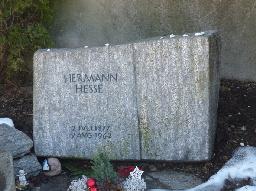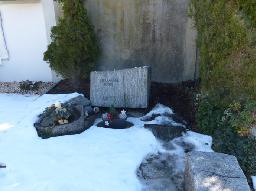Hesse, Hermann |
| WRITER (GERMANY) |
|
BORN 2 Jul 1877, Calw, Baden-Württemberg - DIED 9 Aug 1962, Montagnola, Ticino BIRTH NAME Hesse, hermann Karl CAUSE OF DEATH stroke GRAVE LOCATION Gentilino, Collina d'Oro, Ticino: Cimitero di Sant'Abbondio, Via in Sacca 1 (corner near Via in Sacca) |
|
Hermann Hesse was the son of Johannes Hesse, who started working for the publishing house Calwer Verlagsverein in 1873 and became its manager in 1893. The family left Calw for Basel in 1881, but returned to Calw six years later. Hermann was educated at the Latin School in Göppingen and at the Evangelical Theological Seminary of Maulbronn Abbey from 1891 onwards. But he was often in conflict with his parents and his schools and in 1893 he left school. He worked as a apprentice at a clock tower factory in Calw before he switched to an apprenticeship at a book shop in Tübingen in October 1895. After work he studied theological works, but also Goethe, Schiller, Lessing and the work of Nietsche and the German romantics. In 1896 his poem "Madonna" was published in Vienna and his first volume of poetry appeared in 1897. Another poem resulted in a fan letter from Helene Voigt. She married the publisher Eugen Diederichs in 1898 and to please her he published Hesse's prose collection "Eine Stunde hinter Mitternacht" in 1898. In 1899 he started working in an antique bookshop in Basel. He travelled to Italy in 1901. His mother died in 1902 but he didn't attend her funeral. His novel "Peter Camenzind" (1904) was a sudden success and was popular all over Germany. In 1904 he married Maria Bernoulli (1868-1963) against the wishes of her father. They settled in Gaienhofen and had three sons. In 1906 he published his novel "Unterm Rad" and in 1910 "Gertrud" followed. he had trouble writing it and in 1911 he left Maria behind for a trip to Sri Lanka and Indonesia. After his return they moved to Bern, but by thattime their marriage was in troubled. In 1914 he volunteered for the arm. He was unfit for combat, but received an assignment to care for prisoners of war. After he warned against nationalistic madness in an article he was attacked by the German press and lost many friends. His father died in 1916 and his wife suffered from schizophrenia. He fell into a depression and received psychotherapy and met Carl Jung. Hesse separated from his wife and moved to Montagnola alone in 1919. There he continued his writing and also started painting. His creative powers returned to him and in 1922 he published his novella "Siddhartha". In 1923 he obtained Swiss citizenship and in 1924 he married the singer Ruth Wenger, the daughter of the author Lisa Wenger. In 1927 his friend Hugo Ball published a biography of him. In the same year he divorced Ruth. Also in 1927 he published his novel "Steppenwolf". In 1931 he married the art art historian Ninon Dolbin-Ausländer and he moved with her to a large house nar Montagnola. In 1931 he starte planning his last important novel "Das Glasperlenspiel" that was published in 1943. He was worried about nazism and made a statement by reviewing works by Jewish authors. In 1946 he received the Nobel Prize for literature. During the last part of his life he wrote short stories and poems. He died in Montagnola in 1962. Family • Wife: Hesse, Ninon (1931-1962) Related persons • was a friend of Ball, Hugo • was written about by Ball, Hugo • was visited by Binding, Rudolf G. • was a friend of Hennings, Emmy • visited Rosenbaum, Wladimir • corresponded with Voigt-Diederichs, Helene Theodora |
| Images |
Sources • Hermann Hesse - Wikipedia (EN) |




